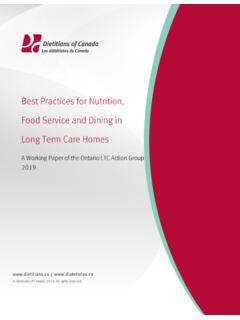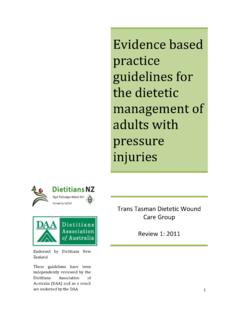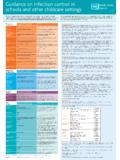Transcription of Quality Assessment and Performance Improvement Plans 2019
1 1 Quality Assessment and Performance Improvement Plans 2019 2 OVERVIEW AND PURPOSE The purpose of Performance Improvement (PI) is to provide a comprehensive data based program that continually assesses the Quality of care provided to the patients and provides feedback that enables the organization to identify adjustments needed to improve patient care. From the Board to the bedside, the focus is providing patient centered care rooted in evidence-based practice and ensuring Medicare Condition of Participation (COPs) are followed. The overarching goal of Covenant s QAPI program is to define patient and family needs, help design safe and effective processes to meet those needs, and ultimately achieve the highest Quality of care coupled with a high level of patient/family satisfaction. Quality STATEMENT The QAPI program is an ongoing, comprehensive, integrated program that provides a transparent view of the Quality of services provided. The QAPI program is a critical component of Covenant s corporate wide planning process and provides the framework for the fulfillment of our mission.
2 It helps ensure the uniform provision of high Quality services throughout the company It identifies opportunities to improve patient and family satisfaction and/or experience of care It ensures that established policies, procedures, and guidelines are followed in the provision of care (including state, federal, accreditation, and professional standards) OBJECTIVES Assess the Quality and appropriateness of all Home Health care Use standardized tools and methodology to demonstrate Improvement Evaluate the adequacy of clinical documentation utilizing standardized audit tools Measure, analyze, and track Quality indicators, including unexpected occurrences and/or adverse events Collect data to monitor and benchmark Identify opportunities for Improvement and evaluate the effectiveness and safety of services Utilize patient and caregiver perception of care and satisfaction and develop Home Health services that are perceived to be of high Quality and value 3 Utilize standard processes to provide effective, efficient, and safe delivery of Home Health care Monitor and evaluate compliance with regulatory requirements and Medicare Conditions of Participation Assist operations with developing Performance Improvement projects (PIPs)
3 When gaps are identified between current and desired status Conduct ongoing QAPI meetings at all levels within the organization to promote a spirit of continual Improvement and associate engagement METHODOLOGY Covenant follows a systematic approach to measuring Quality . Indicators are measurable at the patient level and in aggregate. Data for measuring indicators are collected from clinical documentation, patient/caregiver satisfaction surveys, and administrative indicators. Each indicator will have a level of Performance established as a benchmark or threshold for evaluating care, Quality , and appropriateness. When an indicator shows that Improvement is needed, an action plan should be developed to evaluate the scope and effectiveness of the PI program ensuring actions taken are within the goals of the Home Health program. Covenant adopted the LEAN methodology for continual process Improvement . The guiding principles of LEAN are: The elimination of waste which breaks all activities into two groups: Value added and non-value added Respect for all people This proven methodology is a map and a compass for continual organizational Improvement .
4 LEAN uses the following tools for process Improvement : Value Stream Mapping a tool used to analyze current state and design future state on a large scale Rapid Continuous Improvement targeted events designed to deconstruct the process, identify areas of Improvement , and reconstruct the improved process (includes those closest to the work being done) Standard Work process steps clearly mapped out for consistent Performance Kamishibai LEAN terminology for audits Real-Time Feedback creates a continual feedback loop that corrects the errors closest to the performer Managing for Daily Improvement keeping top priorities in a visual format front and center for all performers 4 Gemba Walks allows leaders the opportunity to see how the process works at the front line Through genuine respect for all people, LEAN promotes a culture of transparency and engagement, encouraging all employees to participate in the change process and embrace the concept of continual Improvement .
5 ASSIGNMENT OF RESPONSIBILITY Governing Body Ultimate responsibility for the QAPI plan and the care that is provided Oversees the development, implementation, and Assessment of the plan Allocates resources as needed Evaluates the effectiveness of the plan Meets at least annually Quality , Risk, Safety, & Compliance Department Development and implementation of education plan regarding Quality principles Prepares annual comprehensive report describing QAPI activities and Performance Improvement Projects Maintain oversight of on-going organization wide QAPI program Ensure the integrity of data collection and reporting Provide guidance and expertise in all areas of Improvement throughout the organization Operational Leaders Ensure development of appropriate action Plans to address areas of Improvement Evaluate effectiveness of implemented actions Report significant findings to appropriate staff and leaders Identify opportunities for Improvement through daily functions Ensure data is collected and turned in timely Participate in Improvement events and activities when requested Conduct team level QAPI discussions on a routine basis QAPI Steering Committee Maintain leadership oversight of continual progress of all departments Ensure
6 Accountability for adherence to action items and Plans through quarterly meetings Provide support and shared experience as a tool to enhance the Improvement process and troubleshoot challenges 5 Quality Subcommittee of the Board of Directors Meet periodically (minimum of twice a year) and ad hoc to discuss and report areas of focused Improvement Enhance board member oversight and engagement in Performance Improvement Promote executive level accountability for ongoing continual Improvement Clinical and Support Staff Identify opportunities for Improvement through daily functions and contact with the internal and external customers Communicate openly with leaders regarding opportunities for Improvement Participate in Performance Improvement activities when requested RESPONSIBILITY OF QAPI STEERING COMMITTEE The QAPI Steering Committee is responsible for evaluating and prioritizing QAPI activities based on the aggregation and analysis of data collected.
7 The QAPI committee has the authority to issue recommendations for action or further study. Committee members should include senior and executive level leaders from all departments within the organization and minutes should be kept to record meeting activities. The Quality , Risk, Safety, & Compliance department is responsible for coordination of the meeting as well as record keeping; however, it is the departmental leaders who are responsible for the presentation and maintenance of their respective data, action Plans , and reporting to the committee itself. Minutes of the meeting should include: Date Members in attendance Agenda Reports and data presented Summary of activities Committee recommendations Action Plans and follow up items and updates if applicable The QAPI Steering Committee should actively participate in the development of the annual plan each year. The committee should review the plan prior to presentation to the Board of Directors.
8 6 CONFIDENTIALITY The Quality , Risk, Safety, & Compliance department maintains all QAPI related records securely and all information is protected by HIPAA regulations. While data trending is necessary to target areas for Improvement , QAPI data should never be used in a punitive fashion. QAPI data should always be shared in a spirit of continual process Improvement . Individual Performance issues identified through Performance Improvement activities should be dealt with on an individual basis following Covenant s standards of Performance excellence. HOME HEALTH CARE DIVISION QAPI Covenant Home Health Care collects QAPI data and monitors results that are reported to the Quality , Risk, Safety and Compliance Department. The home health care division of Covenant Care completes clinical, therapy, medical record audits monthly for each branch. The clinical audit consists of 62 indicators, the therapy audit consists of 48 indicators, and the medical record audit consists of 23 indicators.
9 The Home Health QAPI review also includes the summary of data results from incident reports, fall reports, infection reports, complaint reports, potentially avoidable events report, and updates of three specific action Plans selected for the year. In addition to the before mentioned data and report summaries, the Key Point Indicator (KPI) report based on Medicare reported Outcome and Process Measures is updated monthly. The results of the audits, reports, action Plans , and KPI are sent to the Covenant Care QAPI Coordinator for corporate review. Home Health Specific Action Plans The home health specific action Plans for 2019 will include: 1) Patient Centered Care, 2) Timeliness of Care, 3) wound management . These action Plans are for long term, continual monitoring and revision throughout the year. In certain circumstances requiring immediate response, additional short term action Plans can be developed which can become long term if necessary. In 2018, Medicare implemented a Condition of Participation (COP) for patients to identify a personal goal as part of their home health plan of care.
10 Patient centered care empowers the patient and promotes self-determination. This also fulfills the new COP requirement for the patient to be aware of his/her plan of care. The audit results and feedback from clinical managers indicate that most clinicians are not identifying their patients personal goals or involving their patients in the care planning process. Timeliness of Care is not a new COP, but an important one that can prevent re-hospitalizations. The QAPI results indicate that 94% of our patients are being seen timely; however, the results 7 are less than national and state levels. The patient s start of care and resumption of care are to be done within 48 hours after receiving the initial referral. If the patient is not admitted or resumed within 48 hours, the clinician is to communicate to the referral source which can lead to early intervention and prevention of re-hospitalization. The wound management audit results are better than they were when they were first being audited three years ago; however, the results continue to be low.



